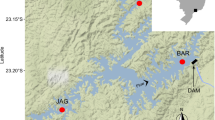Abstract
The furanosesterterpene variabilin was identified in an unpalatable crude extract and proved to be a feeding deterrent when offered at 0.23% of artificial diet dry weight to reef fishes in field assays. The icthyodeterrent property of variabilin was expressed when food pellets for the palatability assays were made with calcium alginate, but not carrageenan. Variabilin probably failed to show deterrent activity in the carageenan matrix because of decomposition during the necessary heat treatment.
Similar content being viewed by others
REFERENCES
Barrow, C. J., Blunt, J. W., Munro, M. H. G., and Perry, N. 1988a. Oxygenated furanosesterterpene tetronic acids from a sponge of the genus Ircinia. J. Nat. Prod. 51:1294-1298.
Barrow, C. J., Blunt, J. W., Munro, M. H. G., and Perry, N. 1988b. Variabilin and related compounds from a sponge of the genus Sarcotragus. J. Nat. Prod. 51:275-281.
Bongiorni, L., and Pietra, F. 1996. Marine natural products for industrial applications. Chem. Ind. 54-57.
CartÉ, B. K. 1996. Biomedical potential of marine natural products. BioScience 46:271-286.
Chanas, B., and Pawlik, J. R. 1995. Defenses of Caribbean sponges against predatory reef fish. II. Spicules, tissue toughness, and nutritional quality. Mar. Ecol. Prog. Ser. 127:195-211.
Cimino, G., Sodano, G., and Spinella, A. 1988. Occurrence of olepupuane in two Mediterranean nudibranchs: A protected form of polygodial. J. Nat. Prod. 51:1010-1011.
Dunlap, M., and Pawlik, J. R. 1996. Video-monitored predation by Caribbean reef fishes on an array of mangrove and reef sponges. Mar. Biol. 126:117-123.
Epifanio, R. de A., Maia, L. F., Pinto, A. C., Hardt, I., and Fenical, W. 1998. Natural products from the gorgonian Lophogorgia punicea: Isolation and structure elucidation of an unusual 17-hydroxy sterol. J. Braz. Chem. Soc. 9(2):187-192.
Epifanio, R. de A., Martins, D. L., VillaÇa, R., and Gabriel, R. 1999. Chemical defenses against fish predation in three Brazilian octocorals: 11β,12β-Epoxypukalide as a feeding deterrent in Phyllogorgia dilatata J. Chem. Ecol. 25:2255-2265.
Faulkner, D. J. 1995. Chemical riches from the oceans. Chem. Br. 680-684.
Faulkner, D. J. 1998. Marine natural products. Nat. Prod. Rep. 2:113-159.
Fenical, W., and Pawlik, J. R. 1991. Defensive properties of secondary metabolites from the Caribbean gorgonian coral Eurythropodium caribaeorum. Mar. Ecol. Prog. Ser. 75:1-8.
Hay, M. E., Satchowicz, J. J., Cruz-Rivera, E., Bullard, S., Deal, M. S., and Lindquist, N. 1998. Bioassays with marine and freshwater macroorganisms, pp. 39-141, in K. F. Haynes and J. C. Millar (eds.). Methods in Chemical Ecology, Volume 2, Bioassay Methods. Chapman and Hall, New York.
McClintock, B., Swenson, D., Trapido-Rosenthal, H., and Banghart, L. 1997. Ichthyodeterrent properties of lipophilic extracts from Bermudian sponges. J. Chem. Ecol. 23:1607-1620.
Nunan, G. W. 1992. Composition, species distribution and zoogeographical affinities of the Brazilian reef-fishes fauna. PhD thesis. University of Newcastle upon Tyne, Newcastle upon Tyne, England.
Paul, V. J., and Fenical, W. 1987. Natural products chemistry and chemical defense in tropical marine algae of the phyllum Chlorophyta. Bioorg. Mar. Chem. 1:1-30.
Pawlik, J. R. 1993. Marine invertebrates chemical defenses. Chem. Rev. 93:1911-1922.
Pawlik, J. R., and Fenical, W. 1992. Chemical defense of Pterogorgia anceps, a Caribbean gorgonian coral. Mar. Ecol. Prog. Ser. 87:183-188.
Pawlik, J. R., Chanas, B., Toonen, R. J., and Fenical, W. 1995. Defenses of Caribbean sponges against predatory reef fish. I. Chemical deterrency. Mar. Ecol. Prog. Ser. 127:183-194.
Pennings, S. C., Pablo, S. R., Paul, V. J., and Duffy, J. E. 1994. Effects of sponge secondary metabolites in different diets on feeding by three groups of consumers. J. Exp. Mar. Biol. Ecol. 180:137-149.
Rogers, S. D., and Paul, V. J. 1991. Chemical defenses of three Glossodoris nudibranchs and their dietary Hyrtios sponges. Mar. Ecol. Prog. Ser. 77:221-232.
Rothberg, I., and Shubiak, P. 1975. The structure of some antibiotics from the sponge Ircinia strobilina. Tetrahedron Lett. 10:769-772.
Thompson, J. E., Walker, R. P., and Faulkner, D. J. 1985. Screening and bioassays for biologically-active substances from forty marine sponges species from San Diego, California, USA. Mar. Biol. 88:11-21.
Zar, J. H. 1984. Biostatistical Analysis, 2nd ed. Prentice Hall, Englewood Cliffs, New Jersey.
Author information
Authors and Affiliations
Rights and permissions
About this article
Cite this article
Epifanio, R.D.A., Gabriel, R., Martins, D.L. et al. The Sesterterpene Variabilin as a Fish-Predation Deterrent in the Western Atlantic Sponge Ircinia strobilina . J Chem Ecol 25, 2247–2254 (1999). https://doi.org/10.1023/A:1020865606047
Issue Date:
DOI: https://doi.org/10.1023/A:1020865606047




